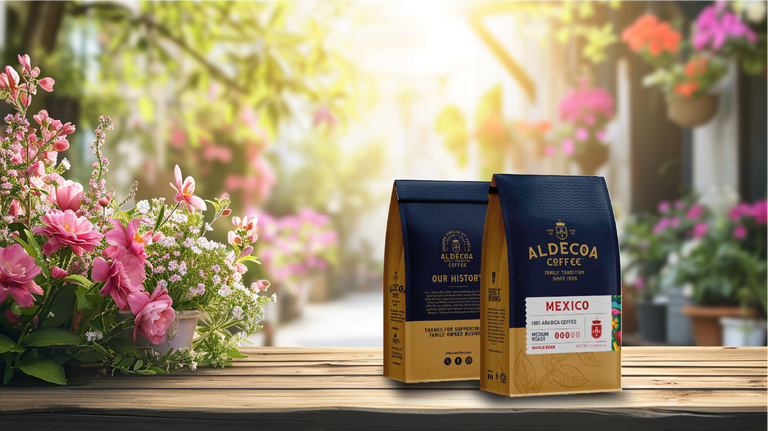Coffee and Gardening: The Surprising Benefits of Coffee Grounds for Your Plants


Share
Spring is just around the corner, and for many of us, that means it's time to think about our gardens. As we prepare to sow seeds and nurture our plants, we often look for natural ways to enrich our soil and enhance plant growth. One of the most surprising ways to help your plants grow is actually your leftover coffee grounds in your kitchen. Not only do these grounds reduce waste, but they also provide a wealth of benefits for our gardens. Let's explore how to use coffee grounds as compost or fertilizer to boost your plants this spring!
The Nutritional Boost Coffee Grounds Provide
Coffee grounds are rich in essential nutrients that can significantly benefit your garden. Here's a quick breakdown of what they offer:
Nitrogen: Coffee grounds are high in nitrogen, an essential nutrient for plant growth. Nitrogen helps plants develop lush, green foliage and supports overall health.
Phosphorus: This nutrient promotes root development and flowering, ensuring plants grow well and flower properly.
Potassium: Potassium helps plants regulate various functions, such as the uptake of water, activation of enzymes, and photosynthesis, that are essential for the growing season.
In addition to the above-mentioned primary nutrients, coffee grounds are rich in trace minerals like calcium, magnesium, and sulfur, providing soil health and plant vitality.
How to Use Coffee Grounds in Your Garden
1. As a Fertilizer
One of the easiest ways to use coffee grounds is to sprinkle them directly onto the soil as a fertilizer. Here's how:
Gather your grounds: Collect used coffee grounds from your coffee maker or local coffee shop. Make sure to let them dry out to prevent mold growth.
Spread evenly: Once dry, spread a thin layer (about 1/4 inch) of coffee grounds over the soil in your garden beds or around potted plants.
Mix into the soil: Rake the grounds into the top few inches to ensure they mix well and effectively contribute to the nutrient content.
2. As Compost
Coffee grounds are an excellent addition to your compost pile. They contribute to the "green" materials necessary for a balanced compost mix. Here's how to incorporate them:
Layering: When building your compost pile, alternate layers of coffee grounds with "brown" materials (like dry leaves, cardboard, or straw) to maintain balance.
Moisture: Coffee grounds help retain moisture in the Compost, which is essential for decomposition.
Aeration: Mixing coffee grounds into your compost adds texture, promotes airflow, and accelerates the breakdown of materials.
3. As a Soil Amendments
Coffee grounds enhance soil structure and drainage. Use them as follows as a soil amendment:
Mix with existing soil: Before planting, mix coffee grounds into the soil to enhance its texture and nutrient content.
Improve drainage: If your garden soil is heavy and compacted, adding coffee grounds can help improve drainage and aeration, creating a healthier environment for your plants.
4. As a Pest Repellent
Interestingly, coffee grounds can also help deter pests. Their pungent aroma is unappealing to certain insects, making them a natural repellent. Here's how to use them:
Sprinkle around plants: Scatter coffee grounds around vulnerable plants to keep pests like slugs, snails, and ants at bay.
Barrier method: Create a barrier of coffee grounds around your garden beds to protect young seedlings from pests.
5. As Mulch
Using coffee grounds as mulch can help retain moisture and suppress weeds in your garden. Here's how:
Apply a thin layer: Spread a thin layer of coffee grounds around your plants to help retain moisture and prevent weeds from sprouting.
Combine with other materials: Mix coffee grounds with organic materials, such as wood chips or straw, for a more effective mulch blend.
What to Do with Used Coffee Grounds: Uses & Benefits
Coffee grounds can be reasonable, but using them wisely is necessary to prevent problems.
Balance: Too much coffee grounds can create an acidic soil pH. Go easy on them, especially for plants that thrive in neutral or alkaline soil.
Run it through: Combine used coffee grounds with other organic materials to provide a rich nutrient mix to your plants.
Avoid unfiltered grounds: If using coffee from a local café, avoid using grounds mixed with flavorings or additives, as these can negatively impact plant health.
The Environmental Impact
Recycling coffee grounds in your garden is great for your plants and helps reduce waste. Reusing something ordinarily discarded promotes a more sustainable method of gardening. This approach aligns with recycling and upcycling, which encourages a healthier planet.
Conclusion
As you prepare your garden for spring, be surprised at what benefits coffee grounds hold as compost or fertilizer. This nutrient-rich residue helps to feed your soil and create a hospitable environment for your plants. When you add coffee grounds to your gardening routine, you can create a verdant garden while being environmentally friendly. Next time you brew a coffee, remember that those grounds will work for your plants! Happy gardening!
